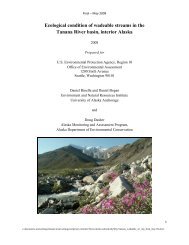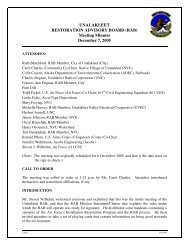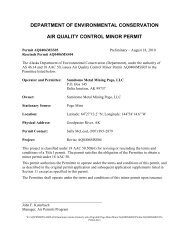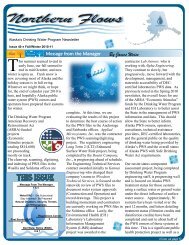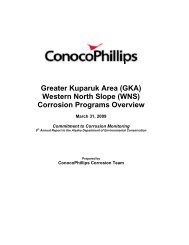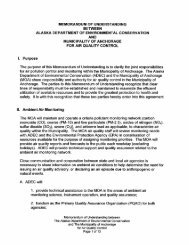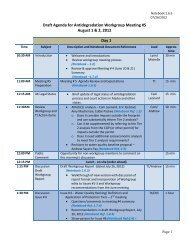2012 Ocean Ranger Guidebook Revision 3-7-12 - Alaska ...
2012 Ocean Ranger Guidebook Revision 3-7-12 - Alaska ...
2012 Ocean Ranger Guidebook Revision 3-7-12 - Alaska ...
Create successful ePaper yourself
Turn your PDF publications into a flip-book with our unique Google optimized e-Paper software.
<strong>20<strong>12</strong></strong> <strong>Ocean</strong> <strong>Ranger</strong> <strong>Guidebook</strong> 3-7-<strong>12</strong><br />
(a) Each foreign vessel which carries more than <strong>12</strong> passengers, or is a tanker, bulk freight vessel, freight vessel, or<br />
self-propelled mobile offshore drilling unit of 500 gross tons or more, operated in U.S. waters, under the authority of a<br />
country not a party to Chapter IX of SOLAS must—(1) Have on board valid documentation showing that the vessel's<br />
company has a safety management system which was audited and assessed, consistent with the International Safety<br />
Management Code of IMO Resolution A.741(18);(2) Have on board valid documentation from a vessel's Flag<br />
Administration showing that the vessel's safety management system was audited and assessed to be consistent with<br />
the International Safety Management Code of IMO Resolution A.741(18); or(3) Show that evidence of compliance<br />
was issued by either a government that is party to SOLAS or an organization recognized to act on behalf of the<br />
vessel's Flag Administration.(b) Evidence of compliance must contain all of the information in, and have substantially<br />
the same format as a—(1) Document of Compliance certificate; and(2) Safety Management Certificate.(c) Failure to<br />
comply with this section will subject the vessel to the compliance and enforcement procedures of § 96.380 of this<br />
part.<br />
Job Aid Item: 5.2.b<br />
Text: Ship rails not less than 42 inches above cabin deck IAW 46 USC 3507 (a(1)).<br />
Background: The Cruise Vessel Security and Safety Act of 2010 applies to large cruise ships (over 250<br />
passengers) and include several items relating to passenger and crew safety. Some of these<br />
requirements have not been implemented, such as training for crime scene preservation. This new<br />
federal law applies to US and foreign passenger vessels. A policy letter from the USCG mentions a date<br />
of January 27, <strong>20<strong>12</strong></strong> as the start for examinations of compliance.<br />
What to check for: Note- you do not need to check every railing. This is an opportunity check to do<br />
while performing other duties.<br />
Citations: 46 USC Sec. 3507 Passenger vessel security and safety requirements<br />
(a) Vessel Design, Equipment, Construction, and Retrofitting Requirements. -<br />
(1) In general. - Each vessel to which this subsection applies shall comply with the following design and<br />
construction standards:<br />
(A) The vessel shall be equipped with ship rails that are located not less than 42 inches above the<br />
cabin deck.<br />
(B) Each passenger stateroom and crew cabin shall be equipped with entry doors that include<br />
peep holes or other means of visual identification.<br />
(C) For any vessel the keel of which is laid after the date of enactment of the Cruise Vessel Security<br />
and Safety Act of 2010, each passenger stateroom and crew cabin shall be equipped with -<br />
(i) security latches; and<br />
(ii) time-sensitive key technology.<br />
(D) The vessel shall integrate technology that can be used for capturing images of passengers or<br />
detecting passengers who have fallen overboard, to the extent that such technology is available.<br />
(E) The vessel shall be equipped with a sufficient number of operable acoustic hailing or other such<br />
warning devices to provide communication capability around the entire vessel when operating in high<br />
risk areas (as defined by the United States Coast Guard).<br />
46 CFR 72.40-5 Where rails required. (Current federal regulations from 1969).<br />
(a) All passenger vessels shall have efficient guard rails or bulwarks on decks and bridges as follows:<br />
The height of rails or bulwarks shall be at least 39 1/2 inches from the deck. At the peripheries of the<br />
freeboard and superstructure decks and at the peripheries of all decks accessible to passengers, rails<br />
shall be in at least three courses including the top. The opening below the lowest course shall not be<br />
more than 9 inches. The courses shall not be more than 15 inches apart. In the case of ships with<br />
176






